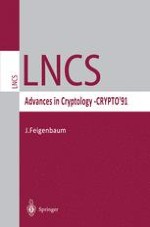1992 | OriginalPaper | Buchkapitel
Practical Quantum Oblivious Transfer
verfasst von : Charles H. Bennett, Gilles Brassard, Claude Crépeau, Marie-Hélène Skubiszewska
Erschienen in: Advances in Cryptology — CRYPTO ’91
Verlag: Springer Berlin Heidelberg
Enthalten in: Professional Book Archive
Aktivieren Sie unsere intelligente Suche, um passende Fachinhalte oder Patente zu finden.
Wählen Sie Textabschnitte aus um mit Künstlicher Intelligenz passenden Patente zu finden. powered by
Markieren Sie Textabschnitte, um KI-gestützt weitere passende Inhalte zu finden. powered by
We describe a protocol for quantum oblivious transfer, utilizing faint pulses of polarized light, by which one of two mutually distrustful parties (“Alice”) transmits two one-bit messages in such a way that the other party (“Bob”) can choose which message he gets but cannot obtain information about both messages (he will learn his chosen bit’s value with exponentially small error probability and may gain at most exponentially little information about the value of the other bit), and Alice will be entirely ignorant of which bit he received. Neither party can cheat (ie deviate from the protocol while appearing to follow it) in such a way as to obtain more information than what is given by the description of the protocol. Our protocol is easy to modify in order to implement the All-or-Nothing Disclosure of one out of two string messages, and it can be used to implement bit commitment and oblivious circuit evaluation without complexity-theoretic assumptions, in a way that remains secure even against cheaters that have unlimited computing power. Moreover, this protocol is practical in that it can be realized with available optoelectronic apparatus while being immune to any technologically feasible attack for the foreseeable future.
